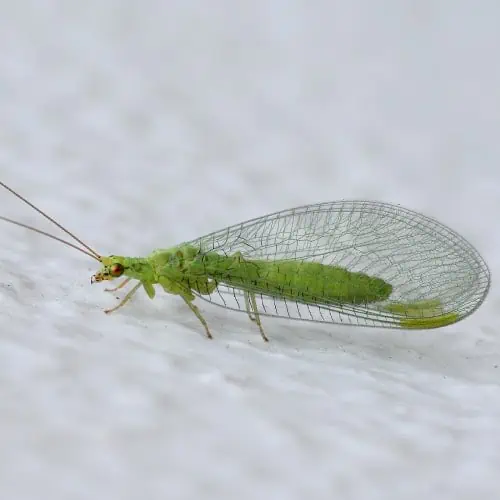
Lacewings are a type of solitary beneficial insect belonging to the family Chrysopidae in the order Neuroptera. This lineage of insects is particularly ancient, dating back to over 100 million years ago. Their common name is derived from the thick veins in their delicate wings, which are always positioned above their body like a tent when not in flight. The green lacewing species in North America are the most common (Chrysopa spp.). They benefit most gardens because each life stage eats insect pests and is entirely harmless to humans. Insects that lacewings feed on include aphids, mealybugs, spider mites, leafhoppers, caterpillars, scale insects, thrips, and whiteflies.
This guide will discuss attracting lacewing larvae and adults to a garden using plants. However, gardeners can purchase lacewings online if natural means of attracting lacewings to a yard are unrealistic.
1) Dill (Anethum graveolens)

Dill is an herb known for its clusters of small, yellow flowers called umbels. This plant captures the attention of ladybugs, lacewings, and parasitic wasps with its vibrant blooms. As the growing season ends, these flowers transform into seeds, ready to be planted in the following season. Dill flourishes in zones 3 to 7 and 9 to 11, and it can even be cultivated during winter.
Hailing from southwestern Asia, dill has been introduced and naturalized across North America. This herb thrives in sunny locations with ample water and well-draining soil for optimal growth, particularly during the summer months.
2) Cilantro (Coriandrum sativum)

Cilantro is another herb that can be used in companion planting, a technique gardeners employ to protect vulnerable plant species by strategically planting trap crops or plants that attract beneficial insects. This herb attracts lacewings to the garden, effectively keeping soft-bodied pests in check. Moreover, when allowed to reach maturity, cilantro produces fragrant leaves and white blossoms that can be utilized as a spice.
Fortunately, cilantro is a low-maintenance herb, making it an ideal choice for home gardeners. It thrives in full sun and requires well-draining soil with a slightly acidic pH ranging from 6.5 to 6.8. Additionally, fresh compost should be added during planting to support its growth.
3) Goldenrod (Solidago spp.)

Goldenrods are flowering plants belonging to the family Asteraceae that are common throughout North America. Asters are a diverse group of flowering plants with a wide array of plant forms and flower colors. Solidago, a genus within the aster family, showcases vibrant yellow flowers that draw in beneficial insects like ladybugs, lacewings, and parasitic wasps. These organisms are attracted to the plentiful nectar the aster provides and will eagerly consume any pests they stumble across. Generally, goldenrods naturally occur throughout North America, and gardeners can easily find a variety that suits their needs.
4) Sweet alyssum (Lobularia maritima)

The following annual belongs to the Brassicaceae family, closely related to familiar vegetables like cauliflower, broccoli, and Brussels sprouts. Sweet alyssum thrives in zones 5 to 9 and contributes to the garden with abundant clusters of small, white flowers. These delicate blooms attract lacewings, which serve as natural predators of aphids, helping to control their populations. Additionally, various cultivars of sweet alyssum offer a palette of pink, purple, or even orange blossoms. Growing sweet alyssum is easy and it can be started indoors up to six weeks before the last frost date. Additionally, another round of seeds can be planted in the fall to encourage a second growing season.
5) Angelica (Angelica archangelica)
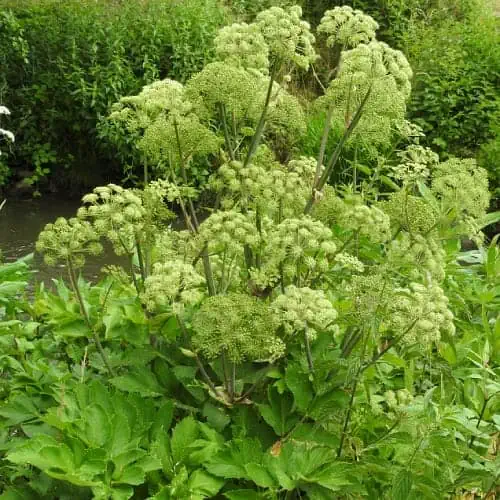
Angelica, or wild celery, stands out in the garden with its towering height and graceful umbels of tiny flowers. The blossoms of this herbaceous plant can vary in color, ranging from white to shades of pink and green. Angelica’s beautiful blooms are attractive to a diverse range of beneficial insects that are in search of the sweet nectar they offer. Additionally, its aromatic foliage and roots possess a distinct fragrance, making it a valued herb for culinary and medicinal purposes. Native to northern Europe, this resilient herb thrives in zones 4 to 7 and, with proper care and attention, angelica can be a stunning addition to any herbal garden or landscape.
6) Yarrow (Achillea millefolium)

Yarrow is a perennial herb and possesses clusters of tiny flowers of various shades, including white, pink, red, or yellow. Like many other plants on this list, yarrow’s blooms can attract beneficial insects. Additionally, the plant possesses nectaries that attract natural enemies to aid in pest control and encourage pollinators to visit. Another of yarrow’s remarkable qualities is its ability to withstand frost, thanks to its fern-like leaves.
This herb is native to Europe and can be found throughout North America. Like many other herbs, yarrow is resilient to drought and frost, making it a hassle-free plant to cultivate and maintain. It thrives best in full sun and well-draining soil conditions.
7) Fennel (Foeniculum vulgare)
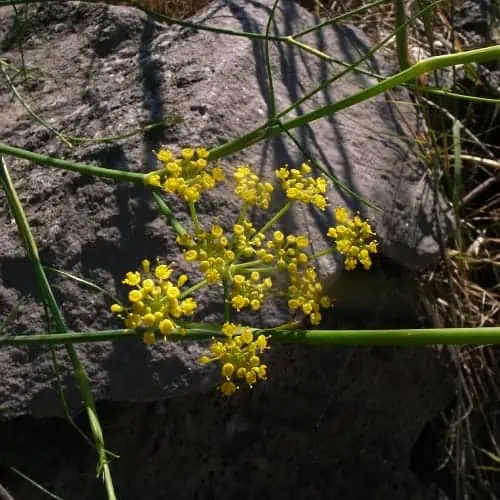
When flowering, fennel presents large, yellow flowers in clusters known as umbels. Belonging to the same family as dill, this herb and its seeds are widely used as a spice. Additionally, the fennel flowers encourage visits from beneficial insects and pest predators to the garden. Interestingly, fennel exhibits two primary variations: herb fennel and vegetable fennel. Herb fennel is cultivated for its seeds, while vegetable fennel is cherished for its leafy greens.
This versatile plant thrives in zones 4 to 9 and exhibits perennial growth in warmer climates, making a comeback year after year. It can still be grown in colder regions but may succumb to freezing temperatures during winter. Fennel thrives in moist conditions, but it is essential to ensure well-draining soil to prevent root rot.
8) Daisies (Bellis spp.)

Daisies are unassuming flowering plants that boast an array of charming and diverse blooms. Their blooms come in various shades, showcasing hues of white, pink, and sometimes even red or purple. Lacewings are just one of the many beneficial insects attracted to daisies’ nectar-rich flowers, lending a helping hand in maintaining a healthy garden ecosystem.
Daisies are also a versatile group, with some varieties kept as ornamental plants and others as attractive ground covers. They can be found throughout North America, and due to their hardy nature, they can flourish year after year, adding a touch of natural and enduring beauty to gardens and landscapes alike.
9) Mountain mint (Pycnanthemum spp.)

Like its other minty cousins, mountain mint possesses fragrant foliage and vibrant flowers. Belonging to the mint family, this herb is characterized as having opposite leaves and fragrant leaves when crushed. As previously mentioned, the plant produces clusters of petite flowers in shades of white or pale lavender, adding hues of color to gardens and attracting a wide range of pollinators and beneficial insects. Its aromatic leaves make it a popular choice for herbal teas, culinary uses, and even medicinal remedies. Mountain mint is also adaptable and thrives in hardiness zones 4 to 8.
10) Tansy (Tanacetum vulgare)
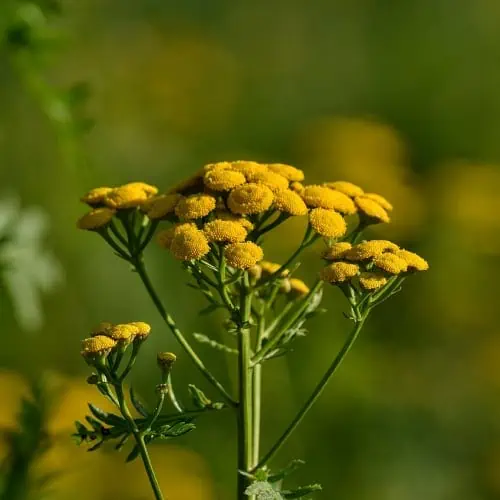
Tansy is native to Europe and Asia but has been naturalized in many parts of North America. It displays dense clusters of bright yellow button-like flowers atop tall, sturdy stems, adding color to gardens and meadows. Tansy leaves are deeply lobed and emit a distinct, pleasant fragrance when touched.
Historically, this herb has been utilized for its medicinal properties and culinary uses, although it can be toxic when ingested in large quantities. Tansy thrives in zones 3 to 8, making it a versatile addition to many herb gardens and natural landscapes. Remember that this plant may be invasive where you live and, therefore, potentially unsuitable for some North American gardens.
11) Queen Anne’s lace (Daucus carota)

Queen Anne’s lace, also known as wild carrot, is an annual herb from the umbellifer or carrot family. This delicate plant displays clusters of exquisite white flowers atop its slender stems. While the entire plant is edible, it contains the toxin falcarinol, which can be harmful if consumed in excess. Queen Anne’s lace is attractive to various pests and their predators, including aphids and beneficial insects that keep them in check.
This herb blooms during the summer and fall seasons. It is not very frost-tolerant and must be planted after the threat of frost has passed. Additionally, it is essential to be mindful of its potential to become weedy and overtake a garden. Preventive measures to control its growth are advisable when cultivating Queen Anne’s lace.
12) Tall grasses (Poaceae spp.)
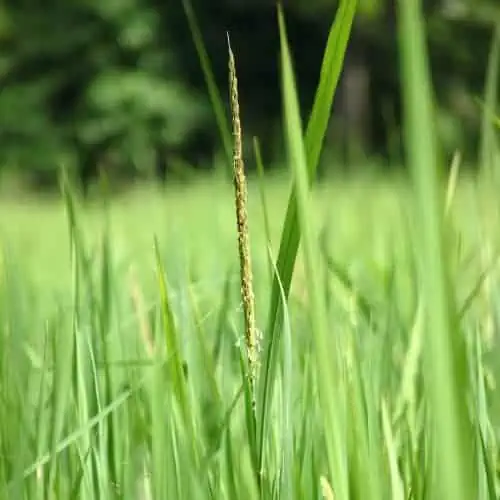
In addition to the flowering plants and herbs previously listed, tall grasses can also attract lacewings and they play an essential role in sheltering these beneficial insects. Lacewings are drawn to the dense foliage and shelter provided by tall grasses, making them an ideal habitat for these valuable predators. Additionally, juvenile lacewings, which need a source of moisture to keep themselves from drying out, will benefit from the humidity trapped in bundles of grass.
The complex structure of tall grasses also offers lacewings ample opportunity to lay their eggs in a protective area, ensuring the presence of multiple generations in a garden. As a result, incorporating tall grasses into landscapes and gardens not only adds beauty and height but also contributes to the overall balance and health of the ecosystem.
How Do I Identify Lacewings & Their Larvae?

Lacewings have thin bodies and can easily be confused with other winged insects like mayflies or dragonflies. Lacewings are unique, however, in that they possess two sets of wings held over their bodies like a tend and long, thin antennae that they use to sense compounds in the air. Lacewing larvae have elongated bodies with three legs, long antennae, and large jaws. The larvae are variably colored but adult lacewings are usually green and only about 1 inch (2.5 cm) long as adults.
Lacewings may be confused with caddisflies (order Trichoptera), which hold their wings above their bodies like lacewings but have fine scales that are easily removed, like the scales on a moth or butterfly. Additionally, caddisfly larvae are aquatic, and only a few species of lacewings have aquatic larvae. Other members of the order Neuroptera to which lacewings belong may also be mistaken for lacewings. These include antlions and dobsonflies.
Why Are Lacewings Good Predators?
Lacewings are carnivorous throughout their lives. They are generalist predators, meaning they will eat many different insect species and do not specialize in any specific group. Their diet usually coincides with lady beetles in that they primarily consume soft-bodied insects like mites, aphids, and scale insects. They are very effective predators and can consume hundreds of insects during their lifespan.
To begin the lacewing’s life cycle, eggs are laid at the ends of thin strands, usually on the bottom of leaves. These strands prevent cannibalism among the larvae and keep the eggs safe from predators. Adults select plants that are the target of pests to give their young the best odds of survival. Lacewing larvae take about four days to hatch into strange, alien-like larvae with huge mandibles that help them capture their prey. The larvae of a few lacewing species will cover themselves in the husks of their game and other debris to hide themselves from predators.

